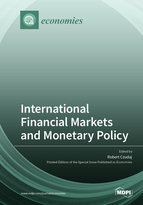International Financial Markets and Monetary Policy
A special issue of Economies (ISSN 2227-7099).
Deadline for manuscript submissions: closed (30 April 2022) | Viewed by 58708
Special Issue Editor
Interests: applied econometrics; time series analysis; Bayesian econometrics; financial markets; exchange rates
Special Issues, Collections and Topics in MDPI journals
Special Issue Information
Dear Colleagues,
The global financial crisis plunged the global economy into a great recession. Many central banks responded with unconventional monetary policies such as quantitative easing, negative policy rates, and forward guidance to calm down financial markets. The COVID-19 pandemic led the global economy, financial markets, and central banks to face even more severe problems. Especially, the ECB set up the pandemic emergency purchase programme (PEPP) to complement the asset purchase programmes that have been in place since 2014 to help the economy to absorb the COVID-19 shock. The new crisis has increased the importance of preserving financial stability through the international cooperation of central banks around the globe. Managing the expectations of market participants plays a crucial role in the context of financial stability. Therefore, the aim of this Special Issue is to disseminate important empirical and theoretical research questions concerning the connection between monetary policy and international financial markets, which might include (but is not limited to):
- Monetary policy transmission in times of uncertainty;
- QE effects on financial markets;
- Negative interest rates and bank lending growth;
- Contagion and spillovers;
- Monetary policy in times of pandemic;
- International coordination of monetary policy.
Prof. Dr. Robert Czudaj
Guest Editor
Manuscript Submission Information
Manuscripts should be submitted online at www.mdpi.com by registering and logging in to this website. Once you are registered, click here to go to the submission form. Manuscripts can be submitted until the deadline. All submissions that pass pre-check are peer-reviewed. Accepted papers will be published continuously in the journal (as soon as accepted) and will be listed together on the special issue website. Research articles, review articles as well as short communications are invited. For planned papers, a title and short abstract (about 100 words) can be sent to the Editorial Office for announcement on this website.
Submitted manuscripts should not have been published previously, nor be under consideration for publication elsewhere (except conference proceedings papers). All manuscripts are thoroughly refereed through a single-blind peer-review process. A guide for authors and other relevant information for submission of manuscripts is available on the Instructions for Authors page. Economies is an international peer-reviewed open access monthly journal published by MDPI.
Please visit the Instructions for Authors page before submitting a manuscript. The Article Processing Charge (APC) for publication in this open access journal is 1800 CHF (Swiss Francs). Submitted papers should be well formatted and use good English. Authors may use MDPI's English editing service prior to publication or during author revisions.






